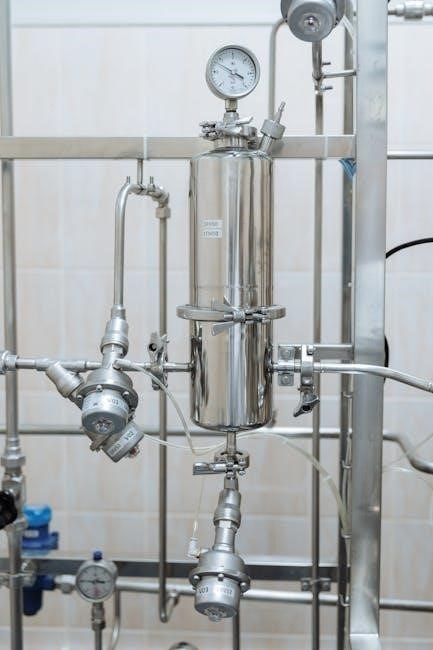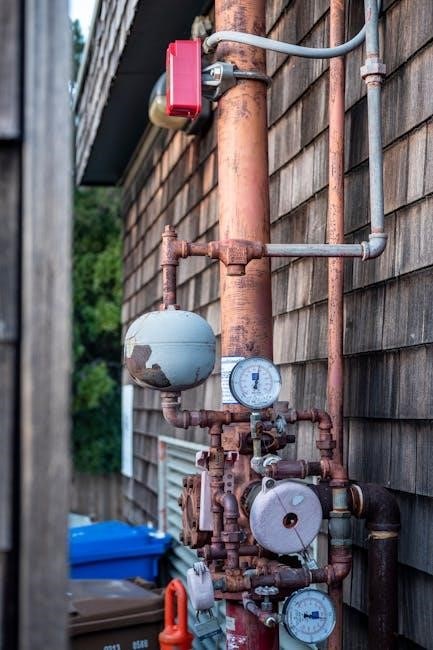and regulations for ensuring pipeline safety and efficiency, as outlined in various pipeline standards and codes, including those from the Plastics Industry Pipe Association of Australia.
Overview of Pipe Pressure Testing
Pipe pressure testing is a critical process that involves verifying the integrity and safety of pipelines, as seen in the practices of companies like American Water, which employs dedicated professionals to provide regulated drinking water and wastewater services. The process typically includes a series of tests and inspections to ensure that the pipeline can withstand the desired pressure and operate efficiently. According to the Plastics Industry Pipe Association of Australia, pipe pressure testing is essential for preventing pipeline failures and ensuring the safe transportation of fluids. The Olivenhain Municipal Water District also emphasizes the importance of pipe pressure testing in maintaining a rewarding working environment and high level of customer service. By understanding the overview of pipe pressure testing, individuals can better appreciate the complexity and significance of this process in various industries, including water and wastewater management. Pipe pressure testing standards are widely available in pdf format.

Importance of Pipe Pressure Testing
Ensuring pipeline safety and efficiency is crucial, as seen in American Water’s practices, with dedicated professionals providing regulated services, emphasizing the importance of pipe pressure testing standards.
Role of Pipe Pressure Testing in Ensuring Safety
Pipe pressure testing plays a crucial role in ensuring the safety of pipelines, as seen in the practices of Olivenhain Municipal Water District, which prioritizes a rewarding working environment and high level of customer service. The district’s focus on safety is reflected in its operation of the Elfin Forest Recreational Reserve. Pipe pressure testing helps to identify potential leaks and weaknesses in the pipeline, allowing for prompt repairs and maintenance. This, in turn, helps to prevent accidents and ensures the safe transportation of water and wastewater. The use of pipe pressure testing standards, such as those outlined in industry guidelines, helps to ensure that pipelines are operated safely and efficiently. By prioritizing pipe pressure testing, utilities can help to protect public health and the environment, while also reducing the risk of costly repairs and maintenance. Effective pipe pressure testing is essential for ensuring the safety and reliability of pipeline systems.
Standards for Pipe Pressure Testing
Standards for pipe pressure testing include guidelines from American Water and industry associations, ensuring safe pipeline operations and compliance with regulations, using established protocols and codes.
ASTM and ASME Standards for Pipe Pressure Testing
ASTM and ASME standards play a crucial role in pipe pressure testing, providing guidelines for testing procedures, equipment, and safety protocols; The American Society of Mechanical Engineers (ASME) and the American Society for Testing and Materials (ASTM) develop and publish standards for pipe pressure testing. These standards ensure that pipelines are designed, constructed, and tested to withstand various operating conditions, including pressure, temperature, and corrosion. The standards also provide guidelines for testing equipment, such as pumps, gauges, and valves, to ensure accuracy and reliability. By following ASTM and ASME standards, pipeline operators can ensure the safety and integrity of their pipelines, reducing the risk of accidents and environmental damage. The standards are regularly updated to reflect advances in technology and industry best practices, and are widely adopted by pipeline operators and regulatory agencies. Pipeline safety is a top priority.

Types of Pipe Pressure Tests
Includes hydrostatic and pneumatic tests, as outlined in industry guidelines for pipeline safety and efficiency, with specific procedures.
Hydrostatic and Pneumatic Tests for Pipes
Hydrostatic and pneumatic tests are two types of pipe pressure tests used to ensure the safety and integrity of pipelines. These tests are conducted to verify that the pipes can withstand the internal pressure without leaking or rupturing. The tests involve filling the pipes with water or air and then pressurizing them to a specified level. The pipes are then inspected for any signs of leakage or damage. Hydrostatic tests are typically used for pipes that will be carrying liquids, while pneumatic tests are used for pipes that will be carrying gases. The tests are an important part of the pipeline construction and maintenance process, and are used to ensure that the pipes are safe and reliable. The results of the tests are used to determine whether the pipes meet the required standards and specifications.

Equipment Used for Pipe Pressure Testing
Specialized equipment such as pumps and gauges are required for pipe pressure testing to ensure accurate results and safety.
Pumps, Gauges, and Valves for Pipe Pressure Testing
Various types of pumps, gauges, and valves are utilized in pipe pressure testing to ensure the pipeline system operates within designated parameters. The pumps used in pipe pressure testing are typically high-pressure pumps that can generate the required pressure to test the pipeline. Gauges are also essential in pipe pressure testing as they provide accurate pressure readings, allowing technicians to monitor the pipeline’s performance. Valves are used to isolate sections of the pipeline, enabling technicians to test specific areas without disrupting the entire system. The selection of pumps, gauges, and valves depends on the pipeline’s material, size, and intended use. Proper installation and maintenance of this equipment are crucial to ensure accurate test results and prevent pipeline damage. By using the right equipment, technicians can identify potential issues and ensure the pipeline operates safely and efficiently.
Procedure for Pipe Pressure Testing
Technicians follow a sequential procedure for pipe pressure testing, involving preparation, testing, and data analysis, using guidelines from organizations like the Plastics Industry Pipe Association of Australia always carefully.
Pre-Test Preparation and Test Execution
Pre-test preparation is crucial for successful pipe pressure testing, involving steps such as reviewing pipeline design and specifications, inspecting the pipeline for any damage or defects, and preparing the necessary equipment and personnel.
The test execution phase involves filling the pipeline with a test fluid, typically water, and then pressurizing it to the specified test pressure, while monitoring the pipeline for any signs of leakage or failure.
According to the Plastics Industry Pipe Association of Australia, proper pre-test preparation and test execution are essential for ensuring the accuracy and reliability of pipe pressure test results, and for identifying any potential issues with the pipeline.
This helps to ensure the safety and integrity of the pipeline, and to prevent any potential failures or breaches.
The pre-test preparation and test execution phases are critical components of the pipe pressure testing process, and must be carefully planned and executed to ensure successful test outcomes.

Interpretation of Pipe Pressure Test Results
Interpreting test results involves analyzing data from pressure sensors and other equipment to determine pipeline integrity and safety, using industry standards and guidelines from organizations like the Plastics Industry Pipe Association.
Acceptance Criteria for Pipe Pressure Tests
The acceptance criteria for pipe pressure tests are established to ensure the pipeline system meets the required safety and performance standards. According to industry guidelines, the criteria include the maximum allowable pressure, leakage rates, and other factors that affect the pipeline’s integrity. The Plastics Industry Pipe Association of Australia provides guidelines for the acceptance criteria, which are used to evaluate the test results. The criteria are based on the type of pipeline, its material, and the operating conditions. The test results are compared to the established criteria to determine if the pipeline meets the required standards. If the pipeline meets the criteria, it is considered safe for operation. The acceptance criteria are an essential part of the pipe pressure testing process, as they provide a benchmark for evaluating the pipeline’s performance and safety. The criteria are used to ensure the pipeline is reliable and efficient.